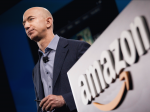Amazon
- Amazon uses a process that involves writing mock press releases to decide which ideas are worth turning into new products.
- The document helps Amazon decide what the main use cases for a product should be.
- Amazon went through this process when developing its latest products it debuted at the end of September, like the Echo Studio and Echo Buds.
- Visit Business Insider's homepage for more stories.
Amazon may be best known for its sprawling online store, where you can have everything from groceries to furniture delivered to your doorstep in just a day.
But thanks to the popularity of its Alexa digital assistant, the ecommerce giant now produces a range of products from the wildly popular Echo smart speaker to connected microwaves, clocks, and more. And while Amazon's product portfolio may be larger and more diverse than ever, there's a simple process the company uses to figure out which ideas are worthy of becoming real products: writing a press release.
This is what has come to be known as the "working backwards document" within Amazon, a mock press release that describes the product and the problem it's trying to solve.
"Everything starts as a working backwards document," Miriam Daniel, Amazon's vice president of Alexa and Echo devices, recently said to Business Insider following the company's fall product launch event. "The reason we write a press release is, when we read it, we want to be able to say as a consumer, 'Wow, I want that.' We write with that end in mind."
All of the devices Amazon unveiled during its event at the end of September started as a working backwards document, says Daniel. The goal of the working backwards document is to help the product team focus on what the main use case for a particular product would be. Daniel points to the Echo Studio, a high-end version of the company's smart speaker that offers improved sound quality over the standard model, as an example of a new product that was created using this process.
"For every one of our speakers, we think about 'What is that hero experience?'" Daniel said. "For [the] Echo Studio, it was re-creating an immersive, studio-like experience."
A report from The New York Times' Karen Weise published in July provides some insight as to what these working backwards documents might look like. The report, which reveals Amazon's ambitions to create its own grocery store that would be separate from Whole Foods, opens with snippets from an internal memo from 2017 outlining the company's vision for new type of supermarket.
As for products that didn't make it past the working backwards document test, Amazon isn't sharing details. That's because there's a chance the idea could be revived in a different way in the future.
"A lot of them come back," Rohit Prasad, Amazon's vice president and head scientist for Alexa, said to Business Insider. "This is why I will not tell you which ones, because they'll come back."
See Also:
- Facebook CEO Mark Zuckerberg will give his 'most comprehensive take' on freedom of speech in a livestream on Thursday
- Google made major changes to the camera on the Pixel 4 — here's our first glimpse at what it can do
- Evan Spiegel and Miranda Kerr just welcomed their second child together. Here are 14 other power couples who rule the tech world.
SEE ALSO: Amazon just announced its first-ever pair of Alexa smart glasses — here's what it's like to use them
